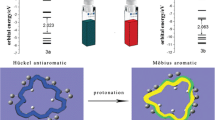Abstract
The effect of a strong electric field generated by molecular dipoles on the ground state electronic structure and the Q and B states as well as the lowest charge transfer (CT) excited state of porphine–2,5-dimethyl-1,4-benzoquinone (PQ) complex has been investigated theoretically. Density functional theory DFT and time-dependent DFT (TDDFT) with the BH&HLYP hybrid functional have been applied in these calculations. The molecular dipole effect was generated by imposing one or two helical homopeptides consisting of eight α-aminoisobutyric acid residues (Aib8) close to the PQ complex. The molecular dipoles in a close proximity to the PQ complex expose it to an electric field of the order of magnitude of 109 V/m. The presence of the ambient molecular dipoles affects mainly the energy of the lowest CT state and barely the energies of the Q and B states. The molecular dipoles affect the energies of the excited states in a similar way as an external electrostatic field. Hence, the electric field induced by the molecular dipoles of the helical peptides could be used analogously to the external electrostatic field to control electron transfer (ET) in the PQ complex.






Similar content being viewed by others
References
Hoff AJ, Deisenhofer J (1997) Phys Rep 287:1–247
Aittala PJ, Cramariuc O, Hukka TI (2010) J Chem Theory Comput 6:805–816
Marchiori CFN, Koehler M (2010) Synt Met 160:643–650
Ohta N, Mikami S, Iwaki Y, Tsushima M, Imahori H, Tamaki K, Sakata Y, Fukuzumi S (2003) Chem Phys Lett 368:230–235
Kimura S (2008) Org Biomol Chem 6:1143–1148
Nakabayashi T, Hino K, Ohta Y, Ito S, Nakano H, Ohta N (2011) J Phys Chem B 115:8622–8626
Hol WGJ (1985) Prog Biophys Mol Biol 45:149–195
Galoppini E, Fox MA (1996) J Am Chem Soc 118:2299–2300
Fox MA, Galoppini E (1997) J Am Chem Soc 23:5277–5285
Nakayama H, Morita T, Kimura S (2009) Phys Chem Chem Phys 11:3967–3976
Gessmann R, Brückner H, Petratos K (2003) J Peptide Sci 9:753–762
Improta R, Barone V, Kudin KN, Scuseria GE (2011) J Am Chem Soc 123:3311–3322
Improta R, Barone V, Kudin NK, Scuseria GE (2011) J Phys Chem 114:2541–2549
Magyar RJ, Tretiak S (2007) J Chem Theory Comput 3:976–987
Treutler O, Ahlrichs R (1995) J Chem Phys 102:346–354
von Arnim M, Ahlrichs R (1998) J Comput Chem 19:1746–1757
Dirac PAM (1929) Proc Royal Soc (London) A 123:714–733
Slater JC (1951) Phys Rev 81:385–390
Perdew JP, Wang Y (1992) Phys Rev B 45:13244–13279
Perdew JP, Burke K, Ernzerhof M (1996) Phys Rev Lett 77:3865–3868
Becke AD (1988) Phys Rev A 38:3098–3100
Lee C, Yang W, Parr RG (1988) Phys Rev B 37:785–789
Becke AD (1993) J Chem Phys 98:1372–1377
Schäfer A, Horn H, Ahlrichs R (1992) J Chem Phys 97:2571–2577
Schäfer A, Huber C, Ahlrichs R (1994) J Chem Phys 100:5829–5833
Bauernschmitt R, Ahlrichs R (1996) Chem Phys Lett 256:454–464
Bauernschmitt R, Häser M, Treutler O, Ahlrichs R (1997) Chem Phys Lett 364:573–578
Furche F, Ahlrichs R (2002) J Chem Phys 117: 7433–7447; (2004) J Chem Phys 121: 12772–12773 (E)
Ahlrichs R, Bär M, Häser M, Horn H, Kölmel C (1989) Chem Phys Lett 162:165–169
Sengupta D, Behera RN, Smith JC, Ullmann GM (2005) Structure 23:849–855
Koch W, Holthausen MC (2001) A chemist’s guide to density functional theory, 2nd edn. Wiley-VCH, Weinheim
Acknowledgments
Prof. H. Lemmetyinen, the head of the Laboratory of Chemistry at Tampere University of Technology, is acknowledged for offering the facilities for this research. Computing resources provided by the CSC – IT Center for Science Ltd, administrated by the Finnish Ministry of Education, are acknowledged. Financing of this research by the Academy of Finland is greatly appreciated.
Author information
Authors and Affiliations
Corresponding author
Rights and permissions
About this article
Cite this article
Cramariuc, O., Aittala, P.J. & Hukka, T.I. Molecular dipole effects on tuning electron transfer in a porphine–quinone complex: a DFT and TDDFT study. J Mol Model 19, 697–704 (2013). https://doi.org/10.1007/s00894-012-1595-9
Received:
Accepted:
Published:
Issue Date:
DOI: https://doi.org/10.1007/s00894-012-1595-9




